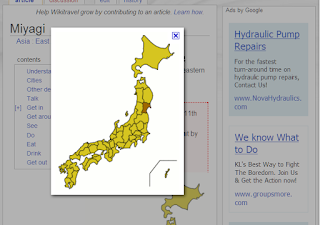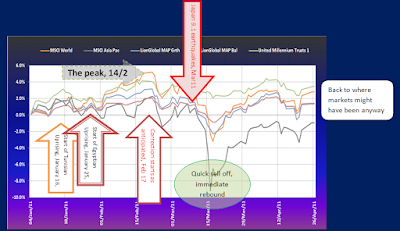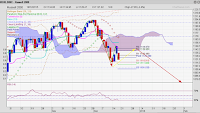Japan Part One: Triple Disaster Forcing a Rethink in Investment Expectations?
I will be publishing several parts on this topic. As you can imagine, assessing the repurcussions of the tragic events in Japan for us investors is rather complex, requiring in-depth research, revisiting previous assumptions and trying to put the changed picture into a context that you, the reader, can evaluate for yourself and - apply to your portfolio strategy.
PART ONE
Japan: In The Throng of a Huge Calamity
 | ||||||
| Where it happened: MIYAGI, also featuring the movie, Karate Kid. |
See what you make the advertisements Google search manages to place next to the picture: 'Hydrolic Pump Repairs' and 'Fight against boredom'. Commercial opportunism on the edge of human etiquette?Similar tenacity was applied during the reconstruction, especially in densely populated areas like Tokyo. Indeed, Tokyo is where seismologists expected a monster earthquake, not Miyagi. The Japanese also took the same great care with the construction of their nuclear plants. This, at least, was how a specialist's report complimented the safety measures applied in the construction, - and now clearly 'visible' after this disaster. It was sent to me by my friend, Flo.
 |
| Nikkei in the week after the earthquake struck, compared with DJIA & DAX |
- Who Sold? The media says: "those who became risk averse"...(overnight?). Honestly, I am guessing here, but it seems so obvious. Foreign investors to Japan were the ones dictating the pace. Reportedly, many Japanese brokers did not even get to work. Another telling indicator: it took all of Monday NIGHT (our time) for the decision makers (in day-time Western countries) to decide on the sharpest sell off action on Tuesday (-12%), which in turn involved ALL major stock markets in the region, the US and Europe. The decision came from outside of Japan! Japanese investors stayed put.
 |
| 3- month View of Nikkei, leading into the crisis. |
- What sold off? Mainly Tepco -24%, the company that runs the nuclear plant, but that was followed by a rout that wiped out US$287 Billion of Japanese stock market.
- US stocks sold off -4%, but also saw the US dollar appreciate just a bit, against the SGD.
- Germany saw the biggest drop with -10% accompanied by a falling Euro.
- STI fell just -5% but also saw the S$ briefly dipping against the USD, - and in particular to the YEN.
Comparable Event: KOBE
 |
| Nikkei in 1995, Kobe earthquake in RED |
Another argument says that in Kobe, the country only (!) had to deal with an earthquake, whereas this time, it is a 3-in-1 disaster. And it is the lingering dangers surrounding a possible nuclear reactor meltdown that leaves the world pondering. From a commercial perspective though, Japan's banks are in much better shape today, the economy has recovered vociferously from the slump in 2008 and the Nikkei is in an uptrend, the first real uptrend in many years, despite a strong Yen. Central banks of the world are synchronising their support for a stable yen, to prevent a repeat of 1995 and generally the parameters for a solution and recovery out the crisis seem more positive then after the Kobe quake.
Conclusion for now:
No two events are ever the same, though we can and do learn from it. Despite the stress and obvious concerns still permeating, the worst repercussions may already be behind us and the world is already refocusing on the other problem areas, like Lybia, and European balance sheets.
In Part two, I shall explore the potential drawbacks and opportunies as Japan's economy is rebuilding, the nuclear issues now surfacing, - and how this fits in with the ongoing revolt in the Islamic nations:
- the effects on gold and precious metal prices
- energy and oil,
- global resources,
- changes in trends
- old fears, new fears
- reassessment of our forecasting parameters for the rest of the year!




Comments